|
| |

South Carolina 2020 Economic Analysis - An examination of the state's economy and workforce.
|
| |

South Carolina 2019 Economic Analysis - The purpose of the South Carolina Economic Analysis Report is to present an overview of key metrics used in examining South Carolina's economy and workforce.
|
| |

SC Earnings Per Hour by Industry - The topic of stagnant industry wages in the U.S. has been discussed in the media for some time. This presentation highlights the average hourly earnings in South Carolina for several notable industry domains and sectors to show what has been the experience in this state.
|
| |

SC Economic Trends - This publication presents information regarding economic trends in South Carolina, including seasonally adjusted employment and unemployment, current employment statistics, consumer price index, building permits, and unemployment insurance claims.
|
| |

Staffing Patterns - Graphical Representations of Staffing Patterns for Key Industries.
|
| |

Employment by Firm Size - The presentation examines private-sector employment in terms of firm size along with the percent breakdown by size category for key geographies and for industry sectors.
|
| |

SC Worker & Industry Employment Stats - Maps and tables highlight various worker and industry employment statistics by S.C. county from the U.S. Census Bureau's Longitudinal Employer-Household Dynamics (LEHD) program.
|
| |

WIOA Regions 2017 CP - This presentation highlights the commuting patterns of the state and the four WIOA regions using the latest available 2017 data from the U.S. Census Bureau's on the Map Application and Longitudinal-Employer Household Dynamics (LEHD) Origin-Destination Employment Statistics Program.
|
| |

WIOA Regions 2016 CP - This presentation highlights the commuting patterns of the state and the four WIOA regions using the latest available 2016 data from the U.S. Census Bureau's on the Map Application and Longitudinal-Employer Household Dynamics (LEHD) Origin-Destination Employment Statistics Program.
|
| |

South Carolina 2018 Economic Analysis Report - This report highlights a number of measures that illuminate several aspects of the state's economy.
|
| |

South Carolina Private-Sector Employment Worker Age - Firm Age Analysis - This presentation examines two aspects of private-sector employment (worker-age and firm-age).
|
| |

2016 South Carolina Industry Analysis - An examination of information on South Carolina's Industries.
|
| |

South Carolina Construction and Manufacturing Industry Trends - This report looks at the trends of employment and wages for the two industries over the past 25 years.
|
| |

South Carolina Local Workforce Development Area (WDA) Employment Metrics - This presentation seeks to examine the employment situation of the state's 12 local workforce development areas using a number of metrics that highlight the state's changing economy over the period from the third quarter of 2003 to the fourth quarter of 2015.
|
| |

How Have Central Commuting Patterns Changed in the 21st Century? - This report analyzes that data from a historical perspective and answers the question "How have commuting patterns for the Central Region changed over time?".
|
| |

How Have Pee Dee Commuting Patterns Changed in the 21st Century? - This report analyzes that data from a historical perspective and answers the question "How have commuting patterns for the Pee Dee Region changed over time?".
|
| |

How Have South Coast Commuting Patterns Changed in the 21st Century? - This report analyzes that data from a historical perspective and answers the question "How have commuting patterns for the South Coast Region changed over time?".
|
| |

How Have Upstate Commuting Patterns Changed in the 21st Century? - This report analyzes that data from a historical perspective and answers the question "How have commuting patterns for the Upstate Region changed over time?".
|
| |

S.C. WIOA Region 2015 Commuting Patterns - This presentation highlights the commuting patterns of the four S.C. WIOA Regions.
|
| |
 2014 South Carolina Regional Commuting Patterns - An In-depth Analysis of the State's Workforce. 2014 South Carolina Regional Commuting Patterns - An In-depth Analysis of the State's Workforce.
|
| |
 2013 South Carolina Regional Commuting Patterns - An In-depth Analysis of the State's Workforce. 2013 South Carolina Regional Commuting Patterns - An In-depth Analysis of the State's Workforce.
|
| |

SC WIOA Regional System - This report presents these data elements for each region and puts the information in context with the state overall.
|
| |

South Carolina Average Hourly Earnings by Industry - The topic of stagnant industry wages in the U.S. has been discussed in the media for some time. This presentation highlights the average hourly earnings in South Carolina for several notable industry domains and sectors to show what has been the experience in this state.
|
| |
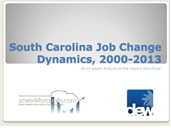
Job Change Dynamics - Job-to-job (J2J) moves are a primary means by which workers move from lower-paying to better-paying employers. This analysis shows job-to-job changes for South Carolina workers by origin and destination for 2000-2013.
|
| |
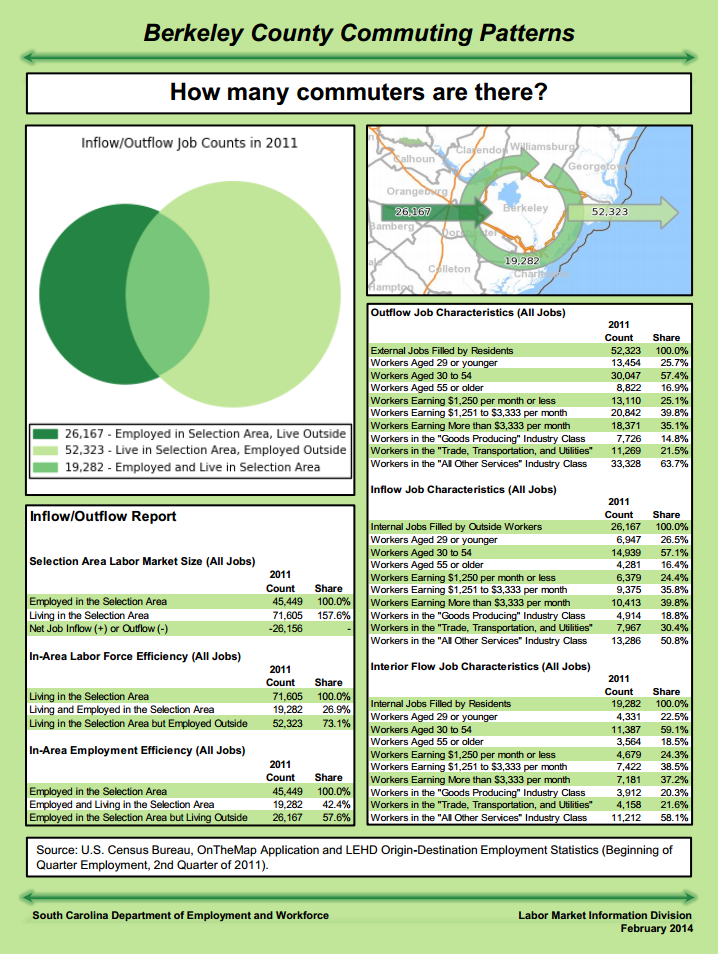
South Carolina Commuting Patterns - View the ten selected counties having the highest differential between inflow and outflow commuters.
|
| |
| |
Information about Science, Technology, Engineering, Art, and Mathematics (STEAM)
Seeing how the arts can assist students in learning, STEM has morphed in STEAM. The two tools below take a look at the current condition, future workforce needs, and comparisons of workforce supply versus employer demand of STEAM jobs in South Carolina |
| |
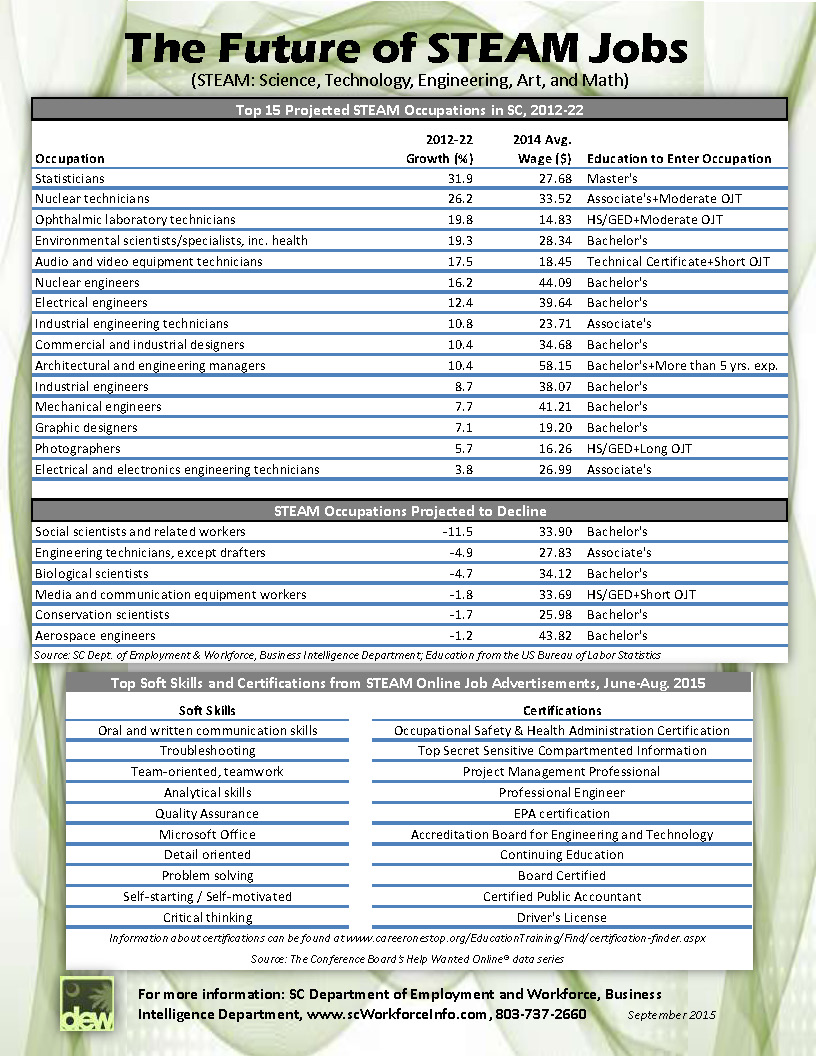
The Future of STEAM |
|
| |
 An Analysis of Supply and Demand
for the
STEAM Workforce in South Carolina An Analysis of Supply and Demand
for the
STEAM Workforce in South Carolina |
| |
| |

LMI Handouts from the Education and Business Summit - These items were delivered at the 2015 SC Education and Business Summit and are geared toward school career counselors and teachers. They include several data sources for information on the job market that will aid in career and/or college decision-making.
|
|
| |
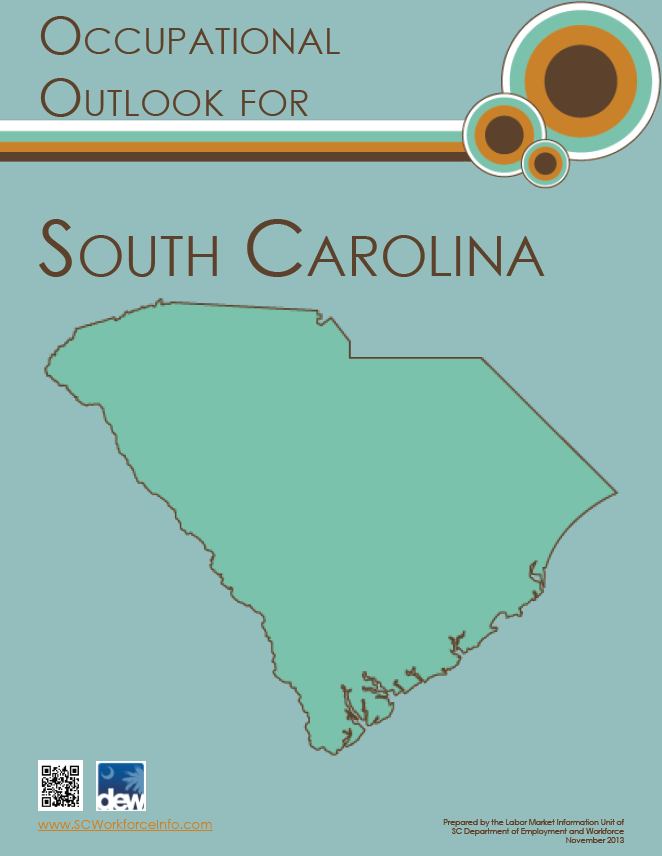
Occupational Outlook - These publications present information regarding the top 20 fastest-growing occupations, top 20 occupations with the greatest number of job openings, and top occupations by education level in South Carolina and for the 12 Local Workforce Investment Areas around the state. |
|
| |
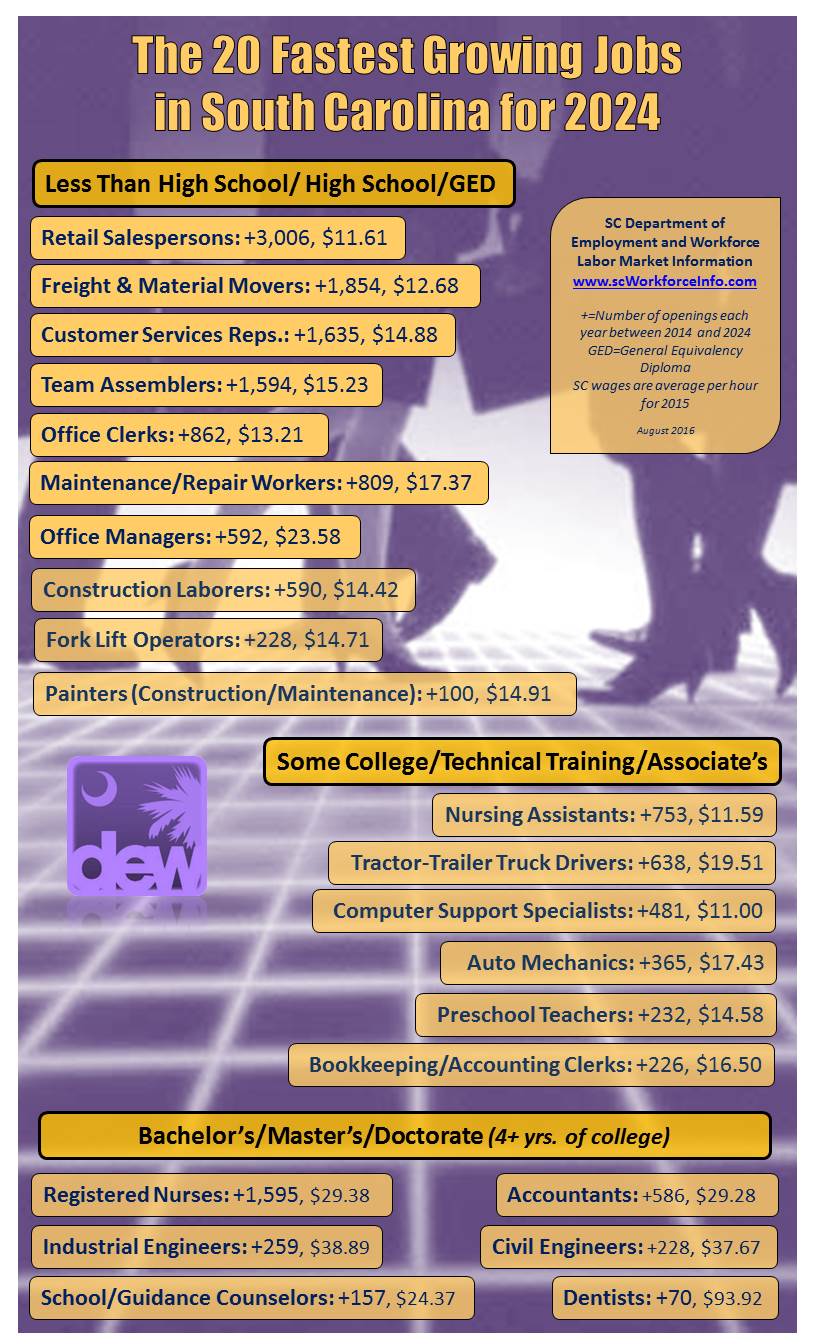
20 Fastest Growing Jobs in SC for 2024 - This poster is legal-sized, and includes projected occupations by education level with wages through 2015. |
|
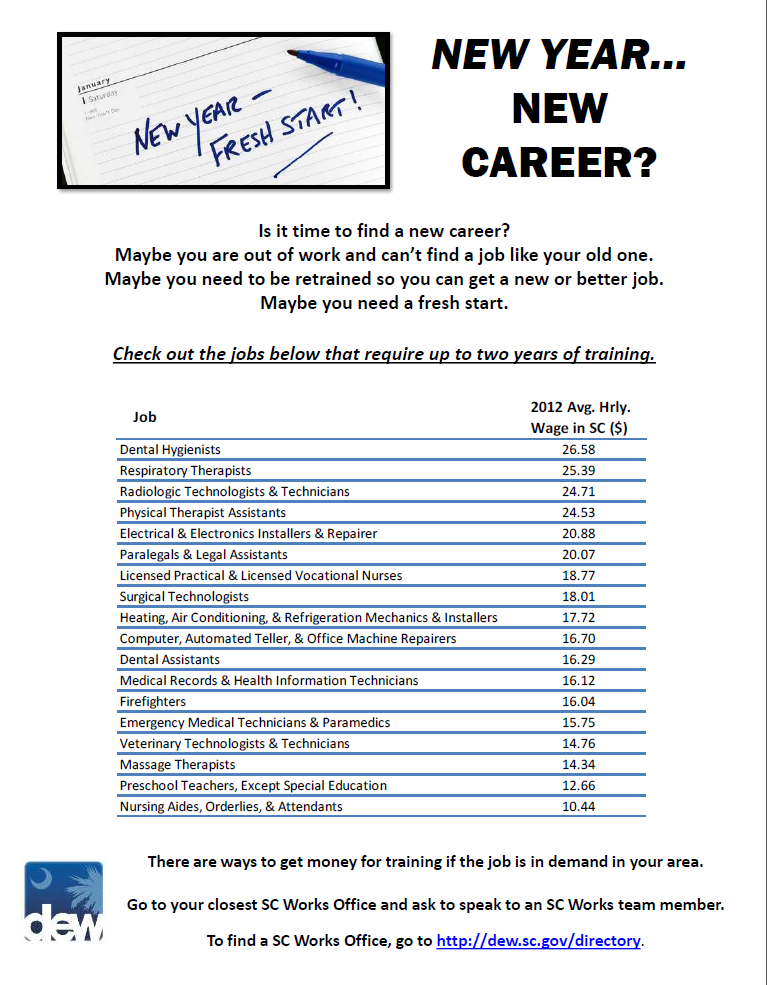
Need a new career? - This publication presents jobs that require up to two years of training, along with their average hourly wage in South Carolina. |
|
|
| |
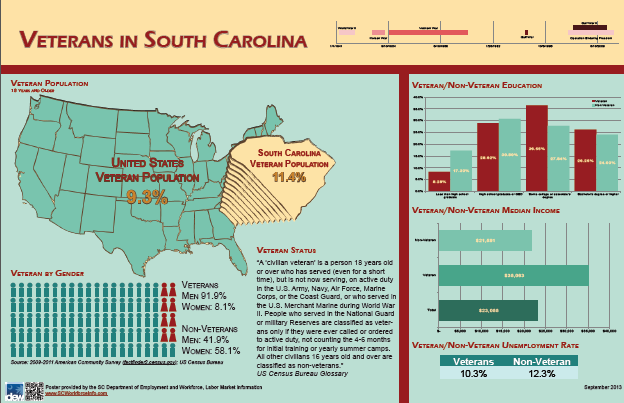
Veterans - This report presents the Veterans' population based on concentration, education, income, and gender in comparison to the Non-veteran population. |
|
| |

WIA & MSA Maps - This series of maps represent current Workforce Investment Areas and Metropolitan Statistical Areas for South Carolina and the new boundaries that have been defined by the Census. |
|
| |

Mass Layoff Statistics - An Annual report on layoff actions that result in workers being separated from their jobs. |
|
|
| |

Good Jobs That Don't Require A 4-Year Degree - This general career information represents various high-growth occupations that do not require a 4-year degree. |
|
| |

Local Employment Dynamics (LED) - Employers, workers, transportation agenies, training institutions, educators, economic developers, and other local decision-makers need current data to help in making decisions. |
|
| |
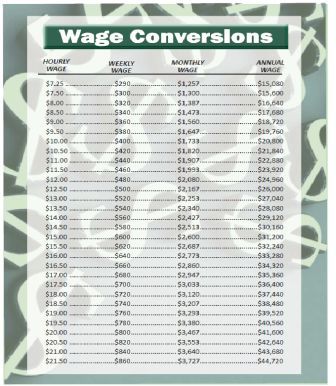
Wage Conversion Brochure - Easily convert an hourly wage to a weekly, monthly, and yearly salary estimate using these formulas. |



